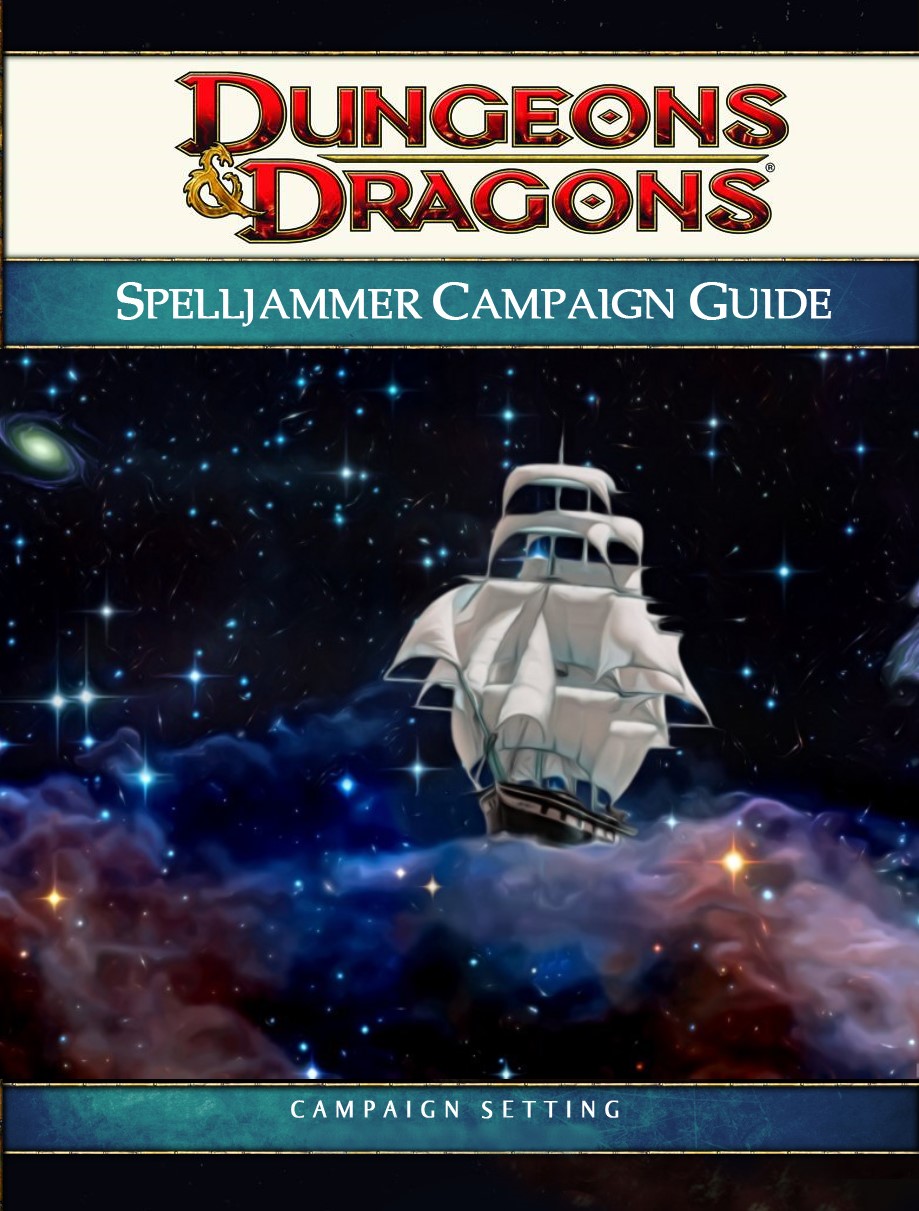
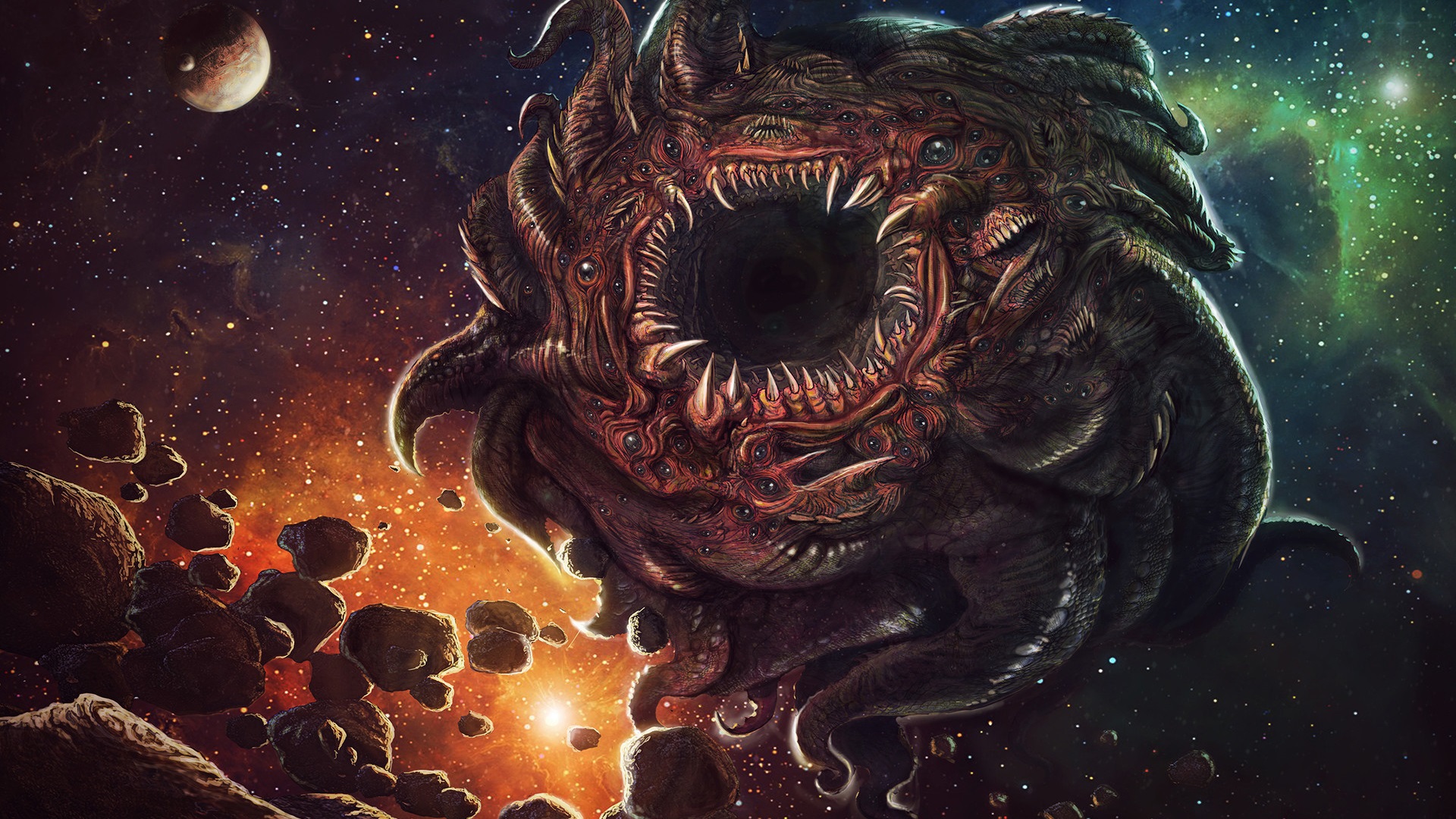

Table of Contents
Version 2.3
-
3Beyond the Planes
- 3Crystal Spheres
- 3Wildspace
- 3The Phlogiston
- 4Gravity
- 4Air
- 4Fire
-
4Magic
- 4Magic Items
- 5Spells
-
5Spelljamming
- 5The Helm
- 8Movement
- 8Crashing a Ship
- 8The Crew
- 9Ship Statistics
-
10Spelljammer Ships
- 11Spelljammer Ship Sheet
- 12Armada
- 12Caravel
- 12Citadel
- 12Damselfly
- 13Deathspider
- 13Dragonfly
- 13Dragonship
- 13Flitter
- 13Galleon
- 14Sidewheeler
- 14Hammership
- 14Man-o-War
- 14Mindspider
- 15Mosquito
- 15Nautiloid
- 15Squid Ship
- 15Tradesman
- 16Tyrant Ship
- 15Wasp
-
17Spelljammer Weapons
- 17Renaissance Weapons
- 18Modern Weapons
- 18Futuristic Weapons
- 20Magical Weapons
-
20Spelljammer Upgrades
- 20Weapon Upgrades
- 20Hull Upgrades
- 20Miscellaneous Upgrades
-
21Factions
- 21The Imperial Elven Navy
- 21The Green Concern
- 21The Arcane Consortium
- 21The Fleshdealers
- 21The Treasure Fleet
- 21The Beholder Sovereignty
- 21The Illithid Union
- 21The Githyanki
- 21The Gith Pirates
Beyond the Planes
Crystal Spheres
Crystal Spheres are exactly what their name entails; they are gigantic spheres made out of magic crystal. These spheres are also sometimes referred to as Crystal Shells. A Crystal Sphere contains all of the planets, moons and suns of each fantasy campaign world.
All wildspace is bounded by crystal shells or Crystal Spheres. Inside the Crystal Sphere is the vacuum of Wildspace, the planets, and stars. Outside the Crystal Sphere is the rainbow ocean of Phlogiston and other Crystal Spheres. The size of a Crystal Sphere is determined by the size of the planetary system inside. Because of their great size, the outside of a Crystal Sphere appears perfectly flat. The curvature is so gradual that it is completely undetectable to anyone who is close enough to see the Crystal Sphere through the obscuring Phlogiston.
Crystal Spheres consists of an unbreakable, dark, ceramic material of unknown origin. Some legends state (and various theologians agree) that the smooth-surfaced shells were created and positioned by the gods themselves to protect their worlds from the ravages of the phlogiston, which is held to be the prime matter of the universe. Less charitable philosophers maintain that such shells were placed by an even higher authority to keep gods and men in and confine their activities. Whatever their origin, the crystal shells are uniform throughout space. All appear as great, dark, featureless spheres of unidentifiable matter. The Crystal Spheres are definitely solid. They have no gravity along either their interior or exterior sides (an exception to the rule that all large objects have gravity).
No magic has been found that can damage or alter the surface of a shell, except for those spells which cause portals to open. Even this, however, is believed to be nothing more than an artificial triggering of a natural phenomenon, since portals also occur naturally and seemingly at random. They are apparently immune to the effects of wishes and even the wills of the outer planar powers (though this does not rule out the possibility that the outer planar powers created them perhaps they were wise enough to prevent even their own tampering).
Wildspace
Between all of the celestial bodies within each Crystal Sphere is a void known as Wildspace. Wildspace is the equivalent of space in the real world. There is no air or gravity within Wildspace.
The Phlogiston
The Phlogiston is an endless ocean filled with a multicolored flammable element that is neither air, earth, fire or water. Very little is known for certain about the Phlogiston, except that the Crystal Spheres float along within it. Currents also flow through the Phlogiston that act as express lanes for Spelljammer ships traveling between the Crystal Spheres. Like Wildspace there is no air or gravity within the Phlogiston.


Gravity
There is no gravity in Wildspace or the Phlogiston. However all celestial bodies larger than 30 feet in diameter generate a gravitational pull equal to that of Earth’s gravity. For a celestial body the force of gravity acts much like it does in our world. Any creature or smaller object on the surface of the body is pulled towards the center. The gravity field of a celestial body extends from its center to it's outermost atmosphere at the edge of Wildspace.
When gravity planes intersect (such as when two ships pass each other, or when a ship passes a planetoid), the gravities of both ships remain in effect, regardless of size, up to the point where they physically intersect. An object is under the influence of whichever gravity plane it is closest to. A character could leap between two passing ships, altering her downward direction as she crosses the midpoint between the two.
Combat in a weightless environment is difficult and foreign to creatures used to fighting in normal environments, and any attack roll or saving throw made in an environment without gravity using Strength or Dexterity is made with disadvantage. The lack of gravity in Wildspace and the Phlogiston affects the travel of normal ranged weapons. Missiles fired beyond a gravity field move unimpeded in a continuous direction until they come in contact with another object or creature.
Air
Since there is no breathable air in Wildspace or the Phlogiston, suffocation may seem like a certainty for groundlings journeying into space. Space-faring races need not worry about such things. Any celestial body larger than 1 mile in diameter generates its own breathable atmosphere. This atmosphere extends from the surface to the edge of Wildspace.
A creature that leaves the air pocket of a celestial body or Spelljammer drags with it a personal envelope of breathable air. The personal envelope has enough air to last 10 minutes before it turns foul. Foul air is not breathable and a creature that cannot hold its breath begins to suffocate until it finds fresh breathable air.
Adventurers unlucky enough to find themselves outside of the air pocket of a Spelljammer ship or bold enough to explore smaller celestial bodies will want to equip themselves with a Pearl of Air. These pearls are mined from the gas giant planets by space dwarves and sold at most space ports. A Pearl of Air provides its holder with enough breathable air to survive outside of an air pocket for 24 hours.
Fire
Within the air envelope of a Spelljammer ship or a celestial body normal and magical fire functions exactly as it would on the ground. However, the lack of air in Wildspace has an affect on fires. Magical fire like Fireball can be cast normally outside of an air pocket, but this fire has no chance of catching anything ablaze. Normal fire will not function at all outside of an air envelope in Wildspace.
Fire in the Phlogiston is extremely deadly. The Phlogiston permeates the air envelope of a Spelljammer ship, and when it comes into contact with a flame it bursts in an explosive mixture.
Spelljammer crews know to extinguish all flames before exiting a Crystal Sphere, however, accidents do happen. The following table shows some examples of fire damage in the Phlogiston.
Fire Damage Table
| Source | Fire Damage | Area of Effect |
|---|---|---|
| Candle | 1d6 | 5-foot-diameter sphere |
| Lantern or Torch | 3d6 | 5-foot-radius sphere |
| Cooking Fire | 5d6 | 10-foot-radius sphere |
Casting any spell that creates magical fire while within the Phlogiston causes the spell to immediately trigger with the caster as the center of the area of effect. If the spell requires a target, the caster is considered to have targeted themselves.
Magic
Magic functions exactly the same from Crystal Sphere to Crystal Sphere. Spells that can be cast in the Forgotten Realms can also be cast on Krynn or any other world. However, magic in the Phlogiston is a different story altogether. The Phlogiston is isolated from the other planes of existence. The peculiar nature of the Phlogiston makes it impossible to cast any spell or use a device or magic item to conjure extraplanar beings, create or open an extradimensional space, travel between different planes of existence, or commune with creatures in a different plane of existence.
Magic Items
Energy Shield Armor
Armor (heavy), rare
As an action, you can activate the armor to generate a energy shield that covers your entire body for 1 minute or until you use a bonus action to end the effect. While activated you gain a +2 bonus to your AC, and your unarmed strikes deal an additional 5 (2d4) lightning damage.
Gravity Armor
Armor (medium, but not hide), uncommon
This armor grants the wearer the ability to walk on any surface without the restrictions of gravity.
As an action, you can activate the armor and walk on walls, ceilings, or any other surface without falling for up to 30 minutes or until you use an action to end the effect.
Pearl of Air
Wondrous Item, uncommon
While this pearl is on your person, it provides you with enough breathable air to survive outside of an air pocket for 24 hours. It takes 12 hours inside a breathable atmosphere with fresh air to recharge.
Stealth Armor
Armor (light), rare
As an action, you can activate the armor to become invisible for up to 10 minutes or until you make an attack, cast a spell, or use a bonus action to end the effect. While you are invisible, anything you are wearing or carrying becomes invisible as long as it is on your person.
Spells
Create Helm
6th-level enchantment
- Casting Time: 1 minute
- Range: Touch
- Components: S, M, V (A chair, stool, or other seat-like object)
- Duration: 24 hours
- Classes: Bard, Wizard
By casting this spell on a normal chair or other seat, this spell transforms that chair or seat into a Spelljammer Helm suitable for powering a Spelljamming ship. The Helm this spell creates is a Minor Helm. The chair reverts to a non-magical object once the spell ends.
You can create a permanent Helm by casting this spell on
the same seat-like object every day for one year.
At Higher Levels When you cast this spell using a spell slot
of 9th level, the Helm you create is a Major Helm instead.
Create or Destroy Air
1st-level transmutation
- Casting Time: 1 action
- Range: 60 feet
- Components: S, M, V (A small, stoppered flask)
- Duration: 10 minutes
- Classes: Cleric, Druid
You either create or destroy air.
Create Air You create, replenish, or refresh the air of one
target creature’s personal air envelope within range for 10
minutes, including air poisoned/tainted by spells such as
Cloudkill and Stinking Cloud. This does not create a larger in
size envelope, but simply replenishes the air in the envelope
that the creature drags with it. If the air is fouled, the air turns
fresh again and the air timer resets to 10 minutes. If used
within a spell or effect that causes a cloud (similar to the Fog
Cloud, Cloudkill and Stinking Cloud spells) the creature is
allowed an immediate save against the effects of the spell.
Destroy Air You immediately turn the personal air envelope
of a target creature within range foul.
At Higher Levels When you cast this spell using a spell slot
of 2nd level or higher, you may target one additional creature
for each slot above 1st.
Portal Magic
2nd-level divination (Ritual)
- Casting Time: 10 minutes
- Range: Half a mile
- Components: S, M, V (A conch shell)
- Duration: 1 minute
- Classes: Bard, Wizard
Casting out to the very Crystal Shell itself, you can sense the direction and distance (either in miles or in travel time) of the nearest portal of egress through a Crystal Shell. In general, from any point on a Crystal Shell, naturally occurring portals for a ship are 2d10 days away. At DM’s discretion, there may be more, less, or no portals.This spell may only be cast within half a mile of the surface of a Crystal Shell.
Portals created by this spell are magical and temporary, so they can be dispelled. If the portal is dispelled or otherwise prematurely closed, roll 1d10, and determine the result the fate of the object(s) passing through the opening as it closes:
1 to 5 - Portal closes before ship reaches the shell. Ship must turn back or Crash into the shell.
6 to 10 - Portal closes after ship passes through.
At Higher Levels When you cast this spell using a spell slot of 5th level or higher, you may draw a circle in the air towards the Crystal Shell. A shimmering portal opens within the circle you drew and remains open for five minutes. The opening does not weaken the shell, and any objects resting physically on the shell are unaffected by the portal.
Spelljamming
The Helm
The spelljammer helm is a large chair or throne which can be piloted by a spellcaster. The helm draws magic from the spellcaster and converts it into energy to move and maneuver a ship.
When placed aboard a vessel weighing between 1 and 100 tons, the helm generates an envelope of fresh air around the ship while it is in the void of space (but not underwater). This envelope extends out from the edges of the hull in all directions for a distance equal in length to the vessel's beam, so that creatures aboard and near the ship can breathe normally in space. The temperature within the air envelope is 70 degrees Fahrenheit.
It also generates an artificial gravity field while the ship is in the void of space, so that creatures can walk on the ship's decks as they normally would. Creatures and objects that fall overboard bob in a gravity plane that extends out from the main deck for a distance equal in length to the vessel's beam.
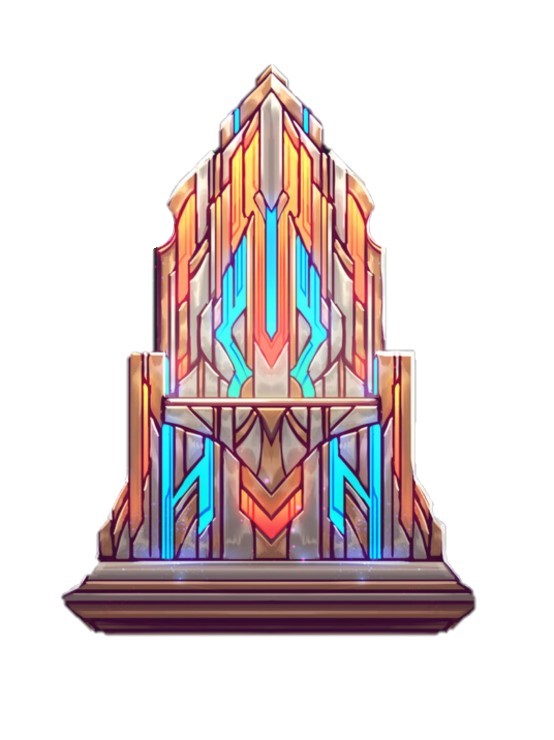
Major Helm
Major Helm
Wondrous Item, legendary (requires attunement by a spellcaster)
This ornate chair is designed to propel and maneuver a ship through space. While attuned to the helm, you cannot expend your own spell slots.
You can use the helm to propel the vessel across or through water and other liquids at a maximum speed in miles per hour equal to your Proficiency bonus + your highest-level unexpended spell slot. It moves 10 times faster through air or space.
Provided you have at least one unexpended spell slot, you can steer the vessel, albeit in a somewhat clumsy fashion, in much the same way that oars or a rudder can maneuver a seafaring ship.
Whenever you like, you can see what's happening on and around the vessel as though you were standing in a location of your choice aboard it.
Minor Helm
Wondrous Item, legendary (requires attunement by a spellcaster)
This ornate chair is designed to propel and maneuver a ship through space. While attuned to the helm, you cannot expend your own spell slots.
You can use the helm to propel the vessel across or through water and other liquids at a maximum speed in miles per hour equal to 1 + your highest-level unexpended spell slot. It moves 10 times faster through air or space.
Provided you have at least one unexpended spell slot, you can steer the vessel, albeit in a somewhat clumsy fashion, in much the same way that oars or a rudder can maneuver a seafaring ship.
Whenever you like, you can see what's happening on and around the vessel as though you were standing in a location of your choice aboard it.
Forge Helm
Wondrous Item, legendary
Found only in a Dwarven Citadel, a Forge Helm or Artiforge is powered by the creative workings of the dwarves using it.
You can use the helm to propel the vessel across or through water and other liquids at a maximum speed of 5 mile per hour for every 100 dwarves working in the forge. It moves 10 times faster through air or space.
Provided you have at least 100 dwarves working in the forge, you can steer the vessel, albeit in a somewhat clumsy fashion, in much the same way that oars or a rudder can maneuver a seafaring ship.
Gnome Helm
Wondrous Item, legendary
These are complicated bits of machinery full of unnecessary gears and levers that power a normal Helm. A Gnome Helm does not require magical power to operate, but instead requires energy generated by adding gnomish devices to produce movement.
You can use the helm to propel the vessel across or through water and other liquids at a maximum speed in miles per hour equal to the number of gnomish devices attached to the helm, up to 10 miles per hour. It moves 10 times faster through air or space.
Provided you have at least two gnomish devices attached to the helm, you can steer the vessel, albeit in a somewhat clumsy fashion, in much the same way that oars or a rudder can maneuver a seafaring ship.
Unstable. A Gnome Helm requires two gnomish devices to function and has a 10% chance to breakdown each day. For each gnomish device added beyond the first two, the Gnome Helm has an additive 5% chance to breakdown. A helmsman must have proficiency with tinker's tools to pilot a Gnome Helm. If the helm breaks down, you can perform an Intelligence (Tinker's Tools) check (DC 20) to repair one of the gnomish devices that broke, or to replace it with a new one. The helm is repaired on a successful check.
Lifejammer Helm
Wondrous Item, legendary
These helms drain the life force of a trapped creature to convert it into motive force. A large or smaller creature trapped within the Lifejammer helm is incapacitated, restrained, and its hit point maximum is reduced by 1d12 per day. A creature dies if their hit point maximum is reduced to 0 in this way.
You can use the helm to propel the vessel across or through water and other liquids at a maximum speed in miles per hour equal to the trapped creature's total Hit Die divided by 2 (rounded down), up to 10 miles per hour. It moves 10 times faster through air or space.
Provided you have at least one creature trapped within the helm, you can steer the vessel, albeit in a somewhat clumsy fashion, in much the same way that oars or a rudder can maneuver a seafaring ship.
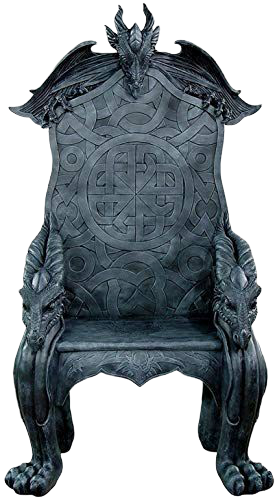
Lifejammer Helm
Series Helm
Wondrous Item, legendary (requires attunement by an Illithid)
Series Helms are specific to the race they were created for, and can be linked to other Series Helms connected to the same ship.
You can use the helm to propel the vessel across or through water and other liquids at a maximum speed of 1 mile per hour. Each additional Series Helm with a pilot linked to this one increases the maximum speed of the ship by 1 mile per hour, up to 5 miles per hour. It moves 10 times faster through air or space.
You can steer the vessel, albeit in a somewhat clumsy fashion, in much the same way that oars or a rudder can maneuver a seafaring ship.
Whenever you like, you can see what's happening on and around the vessel as though you were standing in a location of your choice aboard it.
Pool Helm
Wondrous Item, legendary (requires attunement by an Elder Brain)
This Helm uses the mindflayer’s elder brain pool to power the ship. An elder brain can propel the vessel across or through water and other liquids at a maximum speed of 5 mile per hour. It moves 10 times faster through air or space.
An Edler Brain can steer the vessel, albeit in a somewhat clumsy fashion, in much the same way that oars or a rudder can maneuver a seafaring ship.
An Elder Brain can see what's happening on and around the vessel as though it were standing in a location of its choice aboard it.
Orbus
An Orbus is not a helm, it is a type of beholder that exists to mimic a helm to power and pilot certain beholder ships. An Orbus aboard a vessel can propel the vessel across or through water and other liquids at a maximum speed of 1 mile per hour. Each additional Orbus aboard the vessel increases the maximum speed of the ship by 1 mile per hour, up to 5 miles per hour. It moves 10 times faster through air or space.
An Orbus can steer the vessel, albeit in a somewhat clumsy fashion, in much the same way that oars or a rudder can maneuver a seafaring ship.
An Orbus can see what's happening on and around the vessel as though it were standing in a location of its choice aboard it.
Orbus
Medium abberation, neutral
- Armor Class 15 (natural armor)
- Hit Points 22 (4d8+4)
- Speed 0 ft., fly 20 ft. (hover)
STR DEX CON INT WIS CHA 7 (-2) 13 (+1) 12 (+1) 3 (-4) 13 (+1) 13 (+1)
- Saving Throws Wisdom +3
- Skills Perception +3
- Condition Immunities Prone
- Senses Passive perception 13
- Languages -
- Challenge 1/8 (25 XP)
Antimagic Cone. The orbus’ central eye creates an area of antimagic, as in the antimagic field spell, in a 150-foot cone. At the start of each of its turns, the orbus decides which way the cone faces and whether the cone is active.
Actions
Bite. Melee Weapon Attack: +3 to hit, Reach 5ft., one target. Hit: 4 (1d6+1) piercing damage

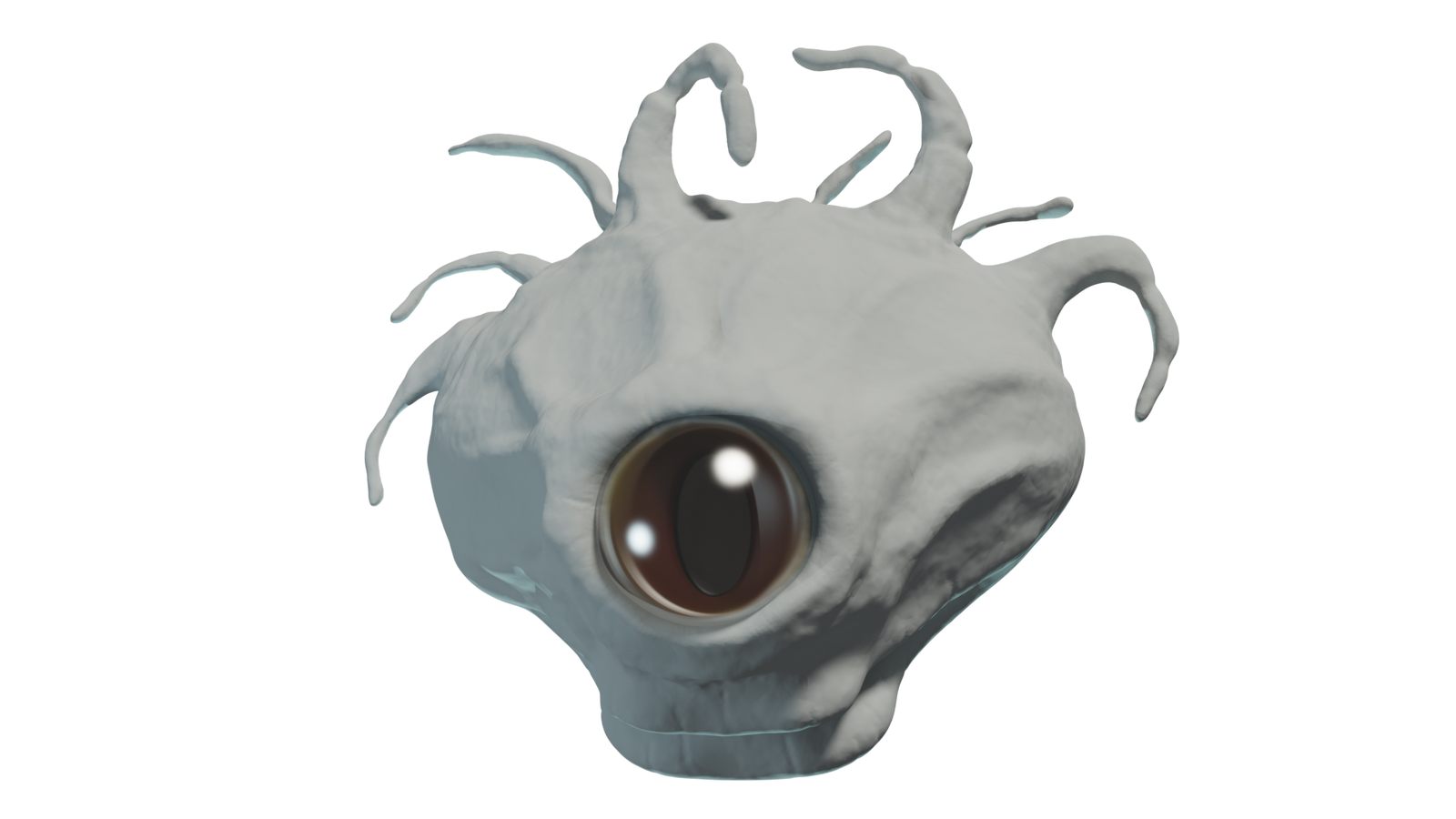
Movement
The travel speed of a Spelljammer ship is determined by its helm and its pilot, however travel in the Phologiston is very different. The Phlogiston contains dense rivers of flammable ether that flow between Crystal Shells. Ships traveling in these currents can achieve speeds that are beyond measure. Generally a ship may travel between crystal spheres within 10d10 days.
The boundary between planetary atmosphere and Wildspace varies between different planets, but generally rests at a distance of 1/1000th of the diameter of the world.
Distance To Reach Wildspace
| Celestial Size Class | Celestial Diameter (Miles) | Distance Above Surface (Miles) |
|---|---|---|
| A | 1,000 | 1 |
| B | 10,000 | 10 |
| C | 100,000 | 100 |
| D | 1,000,000 | 1,000 |
A Spelljammer ship in wildspace or the atmosphere of a celestial object can move direct up or down or backwards without changing the direction it is facing. The ship must be at a complete stop before it can ascend, descend or move in reverse, and the ship moves at half speed while moving in this way — moving 1 foot costs 2 feet of speed — so the ship can cover only half the normal distance in a minute, an hour, or a day.
Crashing a Ship
If a ship moves into the space occupied by a creature or an object, the ship might crash. A ship avoids crashing if the creature or object is at least two sizes smaller than it.
When a ship crashes, it must immediately make a DC 10 Constitution saving throw. On a failed save, it takes damage to its hull based on the size of the creature or object it crashed into, as shown on the Crash Damage table. It also stops moving if the object or creature is one size smaller than it or larger. Otherwise the ship continues moving and the creature or object that collided with it moves to the nearest unoccupied space that isn't in the ship's path. At the DM's discretion, and object that is forced to move but fixed in place is instead destroyed.
A creature struck by a ship must make a Dexterity saving throw with a DC equal to 10 + the ship's Strength modifier, taking damage based on the ship's size (as shown on the Crash Damage table) on a failed save, or half as much damage on a successful one.
Crash Damage Table
| Size | Bludgeoning Damage |
|---|---|
| Small | 1d6 |
| Medium | 1d10 |
| Large | 4d10 |
| Huge | 8d10 |
| Gargantuan | 16d10 |
The Crew
A good crew is the lifeblood of a sailing vessel. A ship cannot sail without a crew, and a crew cannot sail without a ship. They are interlinked, cosmically. The best crews will make voyages pleasant for you and terrible for your enemies.
A Spelljamming ship sailing without a crew will fly at half Speed, as the needed functions of turning the sails, operating the oars, or maintaining the ship itself will have to be done by the party members. All spelljamming ships have two crew numbers - The minimum needed to run the ship, and the maximum that the craft can hold without overloading its atmosphere.
Cannoneer
A ship with weapons requires cannoneers for firing the siege weapons. Cannoneers have proficiency with Vehicles (Land).
Cannoneer Checks. The DM might call for a Cannoneer check when the ship tries to accomplish one of these tasks:
- Move heavy objects with crew members.
- Launch a creature with a catapult.
Captain
The Captain issues orders. They direct other senior crew. The best captains have high Charisma scores, as well as proficiency with Vehicles (Air), Intimidation and Persuasion skills.
Captain Checks. The DM might call for a Captain check when a ship tries to accomplish one of these tasks:
- Handle relations with other ships.
Cook
A ship's Cook works with the limited ingredients aboard a ship to make meals. A skilled cook keeps the crew's morale in top shape, while a poor one drags down the entire crew's performance. A talented cook has a high Constitution score, as well as proficiency with brewer's supplies and cook's utensils.
Cook Checks. The DM might call for a Cook check when the ship tries to accomplish one of these tasks:
- The crew has gone a long time with few rations.
Helmsman
The Helmsman is in charge of navigating the ship through spaces unknown. This station is appointed to, more often than not, the most able-bodied mage aboard a Spelljamming ship. This role is required to be filled for the ship to move throughout Wildspace and beyond. A reliable helmsman tends to have a high Spellcaster level.
Helmsman Check. The DM might call for a Helmsman check when the ship tries to accomplish one of these tasks:
- Piloting the ship in dangerous areas.
Sailor
A competent crew is needed to properly sail a ship. Sailors typically have proficiency with Vehicles (Air). A Commoner from the Monster Manual usually fills this role.
Sailor Checks. The DM might call for a Sailor check when the ship tries to accomplish one of these tasks:
- When you have too few crew to tend the ship.
Shipwright
The Shipwright provides technical advice to the captain and crew and leads repair and maintenance efforts. A good shipwright has a high Strength score, as well as proficiency in tinker's tools or carpenter's tools and the Athletics skill.
Shipwright Checks. The DM might call for a Shipwright check when the ship tries to accomplish one of these tasks:
- Attach a new part to a ship.
- Put out an onboard fire.
Soldier
Ships are often attacked while traveling through wildspace. Soldiers defend the ship when boarded by the enemy. A Guard from the Monster Manual usually fills this role.
Soldier Checks. The DM might call for a Soldier check when the ship tries to accomplish one of these tasks:
- The ship has been boarded by a hostile force.
- Your crew has boarded a hostile ship.
Surgeon
The ship's Surgeon tends to injuries, keeps illnesses from spreading through the ship, and oversees sanitation. A capable surgeon benefits from a high Intelligence score, as well as proficiency with herbalism kit and the Medicine skill.
Surgeon Checks. The DM might call for a Surgeon check when the ship tries to accomplish one of these tasks:
- Perform a medical procedure.
- Treat an onboard plague.
Ship Statistics
Creature Capacity
These two numbers indicate the number of crew required to operate the ship and the total passenger occupancy of the ship.
Cargo Capacity
This indicates the maximum amount of cargo a ship can carry. A vessel can’t move if its cargo exceeds this capacity.
Attributes
Strength A ship’s Strength represents its size and weight. Its Constitution covers its durability and the quality of its construction. Its Dexterity represents a ship’s easy of handling.
Damage Threshold
A ship with a damage threshold has immunity to all damage unless it takes an amount of damage from a single Attack or effect equal to or greater than its damage threshold, in which case it takes damage as normal. Any damage that fails to meet or exceed the ship’s damage threshold is considered superficial and doesn’t reduce the ship’s Hit Points.
Size
The size of a ship is determined by its longest side.
Keel. This is the length of the ship from fore to aft (front to back).
Beam. This is the length of the widest part of the ship from port to starboard (left to right).
Components
A ship is composed of different components. A ship’s component might have special rules, as described in the stat block:
Hull. A ship’s hull is its basic frame, on which the other components are mounted.
Control. A control component is used to steer a ship.
Movement. A movement component is the element of the ship that enables it to move, such as a helm, a set of sails or oars.
Weapon. A ship capable of being used in combat has one or more weapon components, each of which is operated separately.




Spelljammer Ship Table
| Ship | Keel (ft) | Beam (ft) | Creature Capacity | Cargo Capacity | STR | DEX | CON | AC | HP | Damage Threshold | Control | Movement | Cost (gp) |
|---|---|---|---|---|---|---|---|---|---|---|---|---|---|
| Flitter | 20 | 5 | 1/1 | 0.5 | 4 | 20 | 4 | 14 | 40 | N/A | Helm | Major or Minor | 10,000 |
| Mosquito | 100 | 15 | 1/6 | 3 | 7 | 14 | 8 | 17 | 75 | 10 | Helm | Major or Minor | 15,000 |
| Caravel | 70 | 20 | 8/10 | 5 | 7 | 10 | 8 | 13 | 75 | 10 | Helm | Major or Minor | 10,000 |
| Dragonfly | 100 | 20 | 3/10 | 9 | 10 | 14 | 8 | 10 | 100 | 10 | Helm | Major or Minor | 40,000 |
| Damselfly | 100 | 20 | 2/10 | 5 | 10 | 12 | 8 | 10 | 100 | 10 | Helm | Major or Minor | 50,000 |
| Wasp | 80 | 20 | 8/18 | 9 | 11 | 14 | 12 | 16 | 150 | 15 | Helm | Major or Minor | 20,000 |
| Tyrant Ship | 100 | 100 | 15/23 | 11 | 13 | 10 | 15 | 22 | 200 | 20 | Orbus | Orbus | 100,000 |
| Tradesman | 120 | 30 | 10/25 | 18 | 13 | 12 | 15 | 17 | 200 | 20 | Helm | Major or Minor | 15,000 |
| Gnomish Sidewheeler | 120 | 25 | 20/30 | 15 | 15 | 10 | 17 | 15 | 250 | 20 | Helm | Gnomish | 40,000 |
| Nautiloid | 180 | 30 | 10/35 | 17 | 16 | 10 | 18 | 18 | 300 | 20 | Helm | Series or Pool | 40,000 |
| Mindspider | 40 | 15 | 3/40 | 5 | 18 | 18 | 19 | 18 | 400 | 15 | Helm | Lifejammer | 60,000 |
| Galleon | 130 | 30 | 20/40 | 20 | 18 | 10 | 20 | 15 | 400 | 25 | Helm | Major or Minor | 50,000 |
| Squid Ship | 250 | 25 | 12/45 | 23 | 19 | 10 | 21 | 17 | 450 | 25 | Helm | Major or Minor | 45,000 |
| Dragonship | 150 | 20 | 20/45 | 22 | 19 | 12 | 21 | 17 | 450 | 25 | Helm | Major or Minor | 60,000 |
| Hammership | 250 | 25 | 24/60 | 25 | 21 | 10 | 24 | 16 | 550 | 30 | Helm | Major or Minor | 50,000 |
| Man-o-War | 200 | 20 | 10/60 | 30 | 21 | 12 | 24 | 15 | 550 | 30 | Helm | Major or Minor | 100,000 |
| Deathspider | 175 | 50 | 30/100 | 50 | 30 | 4 | 33 | 17 | 1000 | 30 | Helm | Major | 100,000 |
| Armada | 300 | 30 | 40/100 | 50 | 30 | 4 | 33 | 17 | 1000 | 30 | Helm | Major | 125,000 |
| Citadel | 250 | 200 | 100/300 | 300 | 35 | 2 | 38 | 22 | 2000 | 30 | Forge | Forge | 1,000,000 |
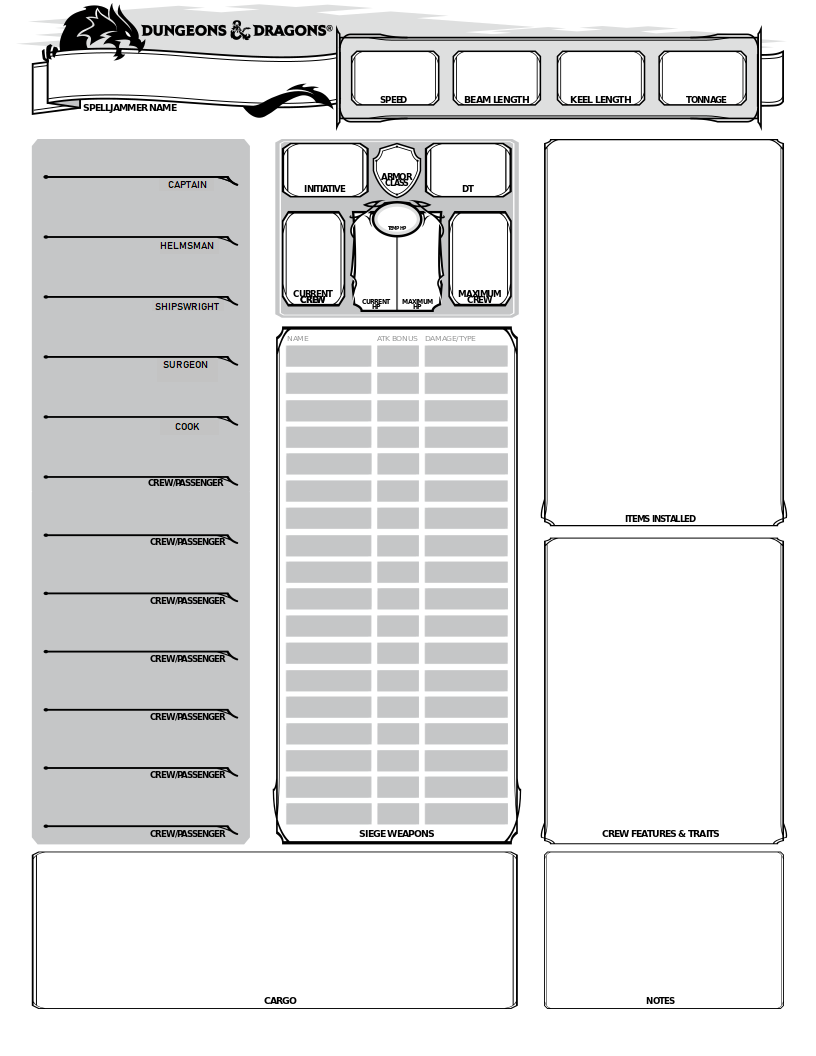
Spelljammer Ships
Below is a list of ships found throughout Wildspace. This list is not exhaustive, but it does include common ships and their sizes. Refer to Pages 119 and 246-247 in the Dungeon Masters Guide for more information about Vehicles.
Armada
The Armada is one of the largest ships in
known space. These massive vessels are used
by elves, and only elves, as mobile military bases.
They are so large that in addition to a huge arsenal
of weapons, they also carry 40 Flitters on board.
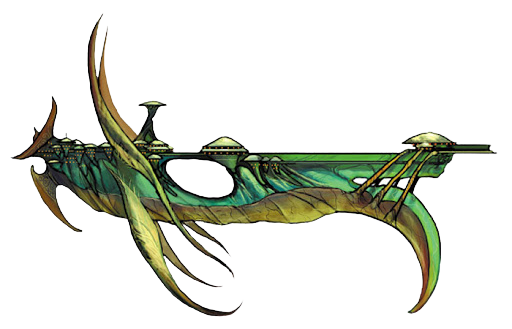
Citadel
The Citadel is actually an asteroid carved and converted by dwarves into a Spelljammer ship. The Citadel acts as a home for space-faring dwarves who mine nearby moons or planets. A Citadel is powered by a Forge not a Spelljammer Helm. The Forge is a room that takes up a good portion of the Citadel. Here the dwarves forge metal and craft items.

Caravel
Caravels are ocean going vessels that have been modified for space travel simply by sticking a Spelljammer Helm on them. Because of this they are not very maneuverable and are often quickly replaced by adventures arriving in space.
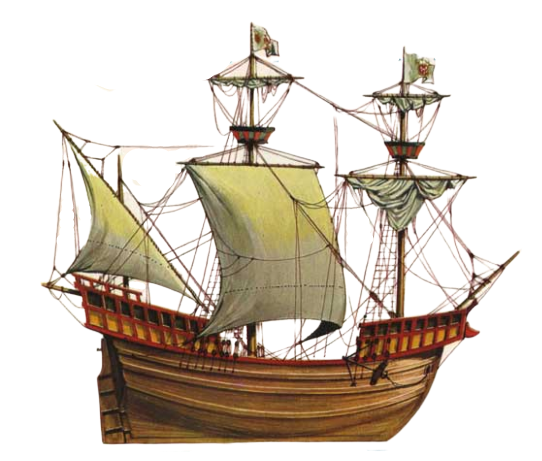
Damselfly
The Damselfly is nothing more than an upgraded Dragonfly that adds more durability and the capacity for larger weapons. These upgrades do come at the cost of a slight decrease in maneuverability.
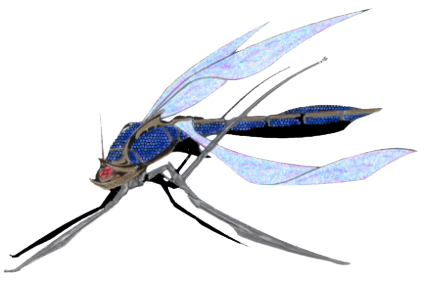
Deathspider
The Deathspider is another ship utilized by the evil Neogi. They are larger than a Mindspider and are operated by a Major Helm not a Lifejammer Helm. The crew of these ships is mostly made up of umber hulk slaves, but the helm pilot is a Neogi mage. These ships have military uses, but are also used to carry cargo or umber hulk slaves.
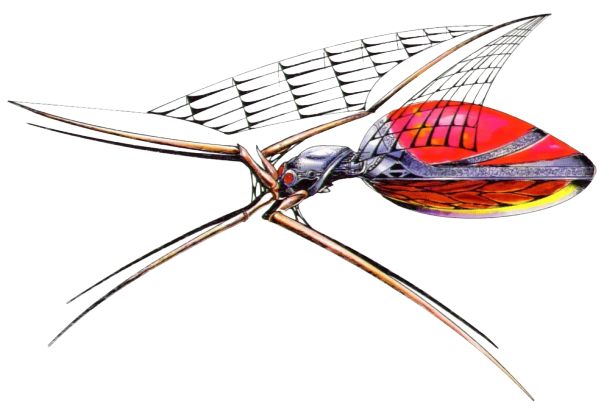
Dragonship
The Dragonship is another attempt by humans to convert a sea vessel into a Spelljammer ship. These ships are mainly used by ground based human empires to expand their territory in the local planetary systems.
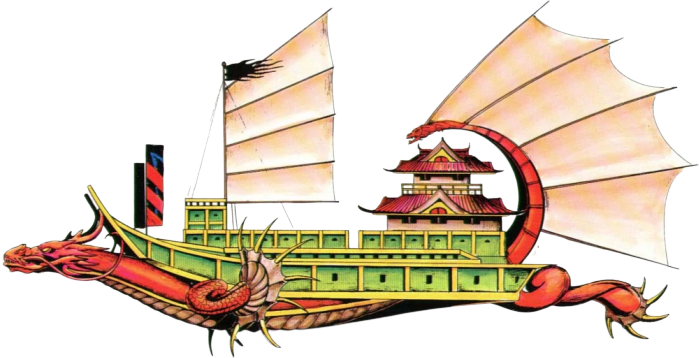
Galleon
Although the Galleon is the best attempt at transforming an ocean going vessel into a Spelljammer ship it still pales in comparison to ships that were purpose built for space. No self respecting space adventurer sails the stars on a Galleon for very long.
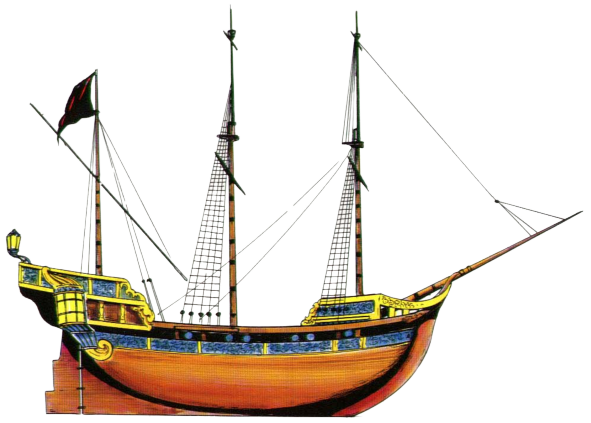
Dragonfly
The Dragonfly is a very popular ship among space-faring humans and elves. This relatively inexpensive ship is built by humans for use in smuggling, exploring, or adventuring.
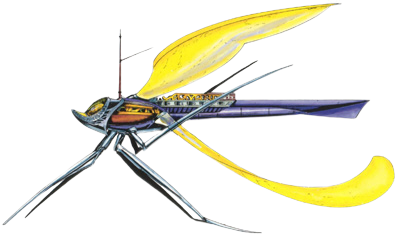
Flitter
The Flitter is the smallest of all the Spelljammer ships. Built
and used by elves this vessel is usually found aboard a larger
ship where it can be used as a messenger ship, scout craft,
landing ship or a fighter.
4
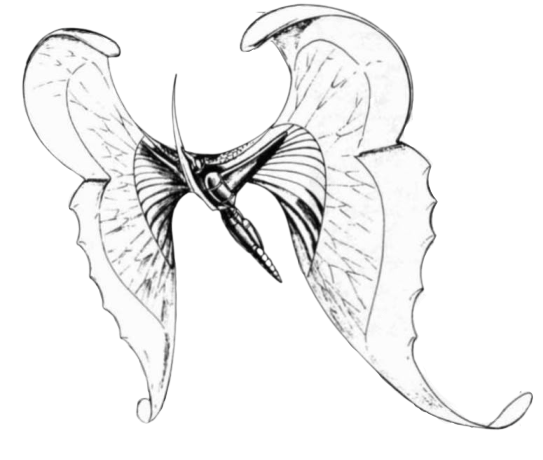
Sidewheeler
A Sidewheeler is the product of gnomish “ingenuity”. They are over-engineered and lacking any grace or beauty. These vessels are powered by Gnomish Helms. Space gnomes use their Sidewheelers to do all of the things that gnomes normally do.
Because of their unstable construction,
sidewheelers were usually ill-suited for
landing on the ground or staying afloat
on water. Since the chance of accident
was high, sidewheeler crews either never
landed or sometimes prepared to brace
the ship together with improvised material.
In other cases, they simply allowed the ship
to crash and then rebuilt another one from the wreckage.
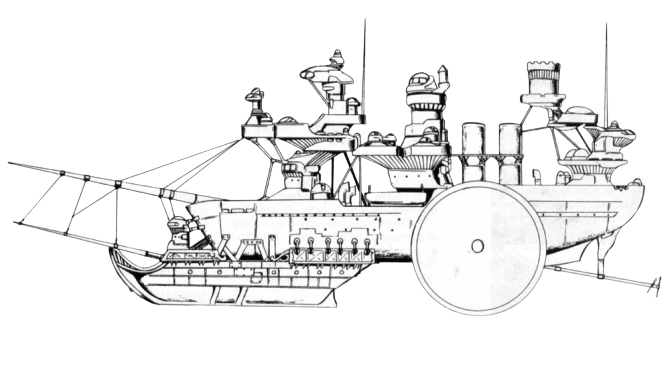
Man-o-War
The Man-o-War is the most prominent ship in the navies of the space-faring elf nations. It is heavily armed and can withstand large amounts of damage before breaking apart.
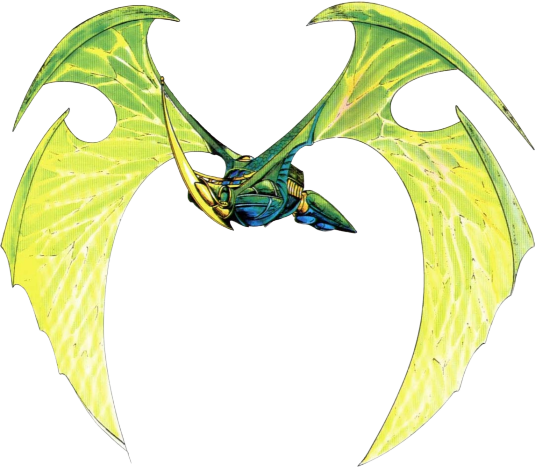
Hammership
Like the Squid Ship the Hammership was built by spacefaring humans to serve in naval armadas. The Hammership is slightly more durable and more heavily armed than its sister ship. Like all the ships of known space Hammerships are often retrofitted for use by pirates.
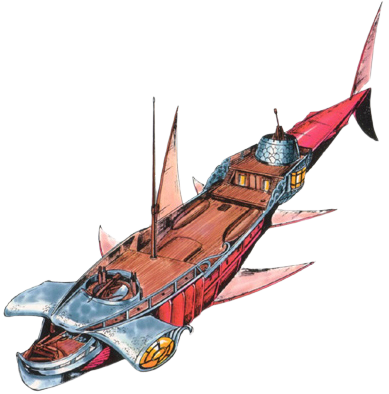
Mindspider
The Mindspider is built and operated by the Neogi, a race of evil beings that terrorize all of known space. These vessels are powered by Lifejammer Helms. Mindspider ships are used by the Neogi to attack other space-faring vessels without provocation or mercy.
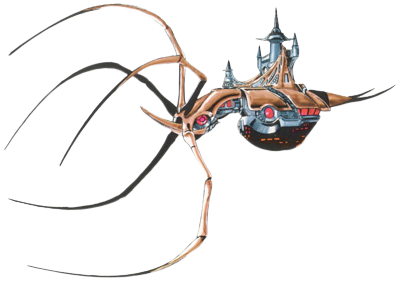
Mosquito
Mosquitoes are human built ships that are used by all races in space. The Mosquito fills many of the same functions as the Flitter, but it can also carry up to six people.
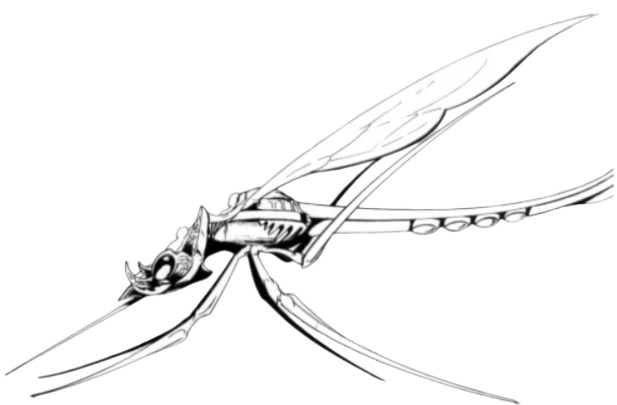
Squid Ship
One of the largest ships built by humans, the Squid
Ship is
prized for military applications. However,
these vessels have
also been adapted by crews
for use in piracy and adventuring.
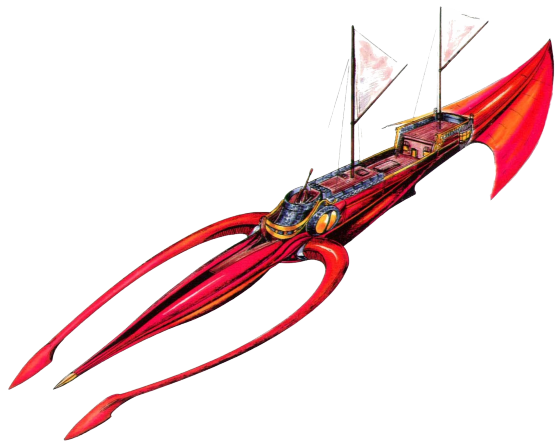
Wasp
The Wasp is purpose built by Lizard Men to suit their needs, but is also frequently used by humans. This vessel is not as armored as a Damselfly, but can absorb a higher amount of damage.
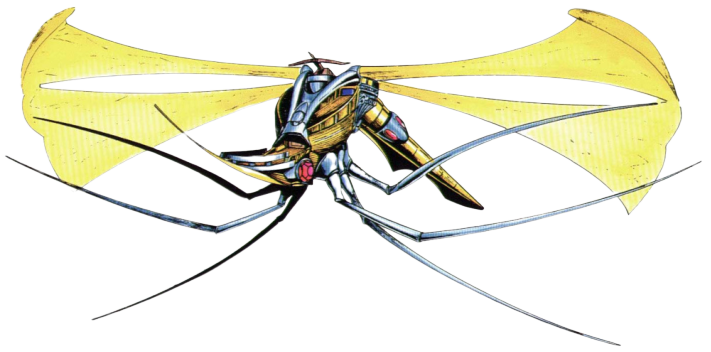
Nautiloid
These are standard ship for the Illithid nations of space. The mind flayers power these vessels with either Series Helms or a Pool Helm. Nautiloid ships are used for military purposes, piracy and trading.
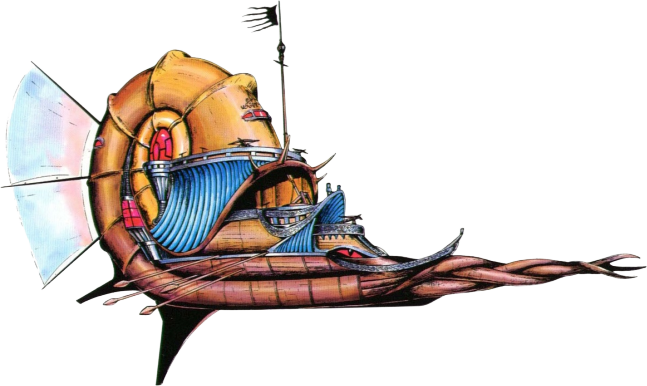
Tradesman
The Tradesman is one of the workhorses of space. They are built by humans, but used by all of the space-faring races. Tradesman ships are ideal for trading, adventuring, or even a little piracy.
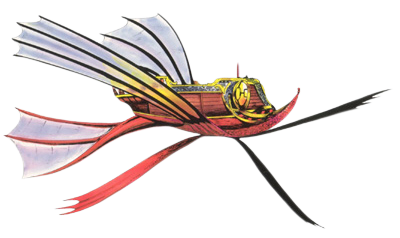
Tyrant Ship
Tyrant Ships are used by beholders. These ships have no common form instead individually reflecting the style of the particular clan of beholders that operate them. Tyrant Ships do not use Spelljammer helms, instead they are powered by an Orbus. A Tyrant Ship does carry traditional ship weapons, but it is capable of firing a beam that is 1,500 feet long by 100 feet wide. This beam is powered by a circuit of at least three beholders including one common beholder, one Orbus and one Hive Mother. Its effects are identical to those of the common beholder eye beam but one additional creature may be targeted for each common beholder in the circuit. In addition the following increases can be made:
Telekinetic Ray. If the target is an object that isn't being worn or carried increase the carrying capacity by 300 lbs for each common beholder in the circuit.
Disintegration Ray. If the target is a Huge or larger non-magical object increase the area disintegrated by an additional 10-foot cube for each common beholder in the circuit.
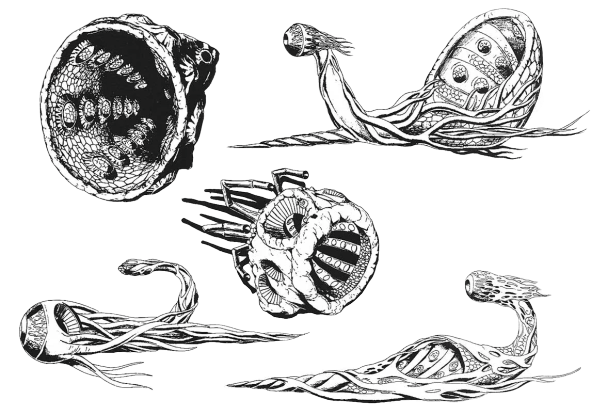



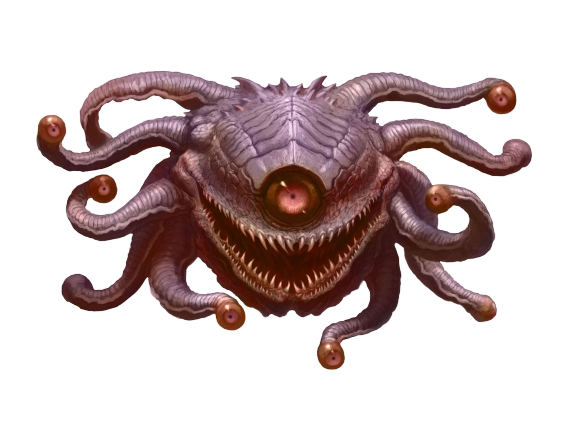

Weapons
Ship weapons are mostly modified from the siege equipment used by ground-based peoples. Most ships employ a combination of ranged weapons as well as having a ram installed on the prow of the ship.
Most weapons require one creature to aim, one to load, and one to fire, but larger more complicated siege weapons may require multiple creatures for each step of its operation.
Renaissance Weapons
Mangonel
Large object
- Armor Class: 15
- Hit Points: 100
- Damage Immunities: poison, psychic
A mangonel is a type of catapult that hurls heavy projectiles. If fired in the gravity field of a celestial object the payload moves in a high arc, so it can hit targets behind cover.
Before the mangonel can be fired, it must be loaded and aimed. It takes two actions to load the weapon, two actions to aim it, and one action to fire it. A mangonel typically hurls a heavy stone, although it can hurl other kinds of projectiles, with different effects.
Mangonel Stone. Ranged Weapon Attack: +5 to hit, range 200/800 ft. (can't hit targets within 60 feet of it), one target. Hit: 27 (5d10) bludgeoning damage
Trebuchet
Huge object
- Armor Class: 15
- Hit Points: 150
- Damage Immunities: poison, psychic
A trebuchet is a powerful catapult that throws its payload. If fired in the gravity field of a celestial object the payload moves in a high arc, so it can hit targets behind cover.
Before the trebuchet can be fired, it must be loaded and aimed. It takes two actions to load the weapon, two actions to aim it, and one action to fire it. A trebuchet typically hurls a heavy stone. However, it can launch other kinds of projectiles, such as barrels of oil or sewage, with different effects.
Trebuchet Stone. Ranged Weapon Attack: +5 to hit. range 300/1,200 ft. (can't hit targets within 60 feet of it), one target. Hit: 45 (8d10) bludgeoning damage.
Ballista
Large object
- Armor Class: 15
- Hit Points: 50
- Damage Immunities: poison, psychic
A ballista is a massive crossbow that fires heavy bolts.
Before it can be fired, it must be loaded and aimed. It takes one action to load the weapon, one action to aim it, and one action to fire it.
Bolt. Ranged Weapon Attack: +6 to hit, range 120/480 ft., one target. Hit: 16 (3dl0) piercing damage.
Arbalest
Large object
- Armor Class: 15
- Hit Points: 75
- Damage Immunities: poison, psychic
An arbalest is a massive crossbow that fires heavy bolts. Before it can be fired, it must be loaded and aimed. It takes one action to load the weapon, one action to aim it, and one action to fire it.
Bolt. Ranged Weapon Attack: +8 to hit, range 200/800 ft. (can't hit targets within 60 feet of it), one target. Hit: 16 (3dl0) piercing damage.
Cannon
Large object
- Armor Class: 19
- Hit Points: 75
- Damage Immunities: poison, psychic
A cannon uses gunpowder to propel heavy balls of cast iron through the air at destructive speeds. In a campaign without gunpowder, a cannon might be an arcane device built by clever gnomes or wizardly engineers. A cannon is usually supported in a wooden frame with wheels. Before it can be fired, the cannon must be loaded and aimed. It takes one action to load the weapon, one action to aim it, and one action to fire it.
Cannon Ball. Ranged Weapon Attack: +6 to hit, range 600/2,400 ft., one target. Hit: 45 (8d10) bludgeoning damage.
Harpoon Flinger
Medium object
- Armor Class: 14
- Hit Points: 50
- Damage Immunities: poison, psychic
A harpoon flinger launches a projectile similar to a javelin into a target. The harpoon flinger grants half cover to the creature operating the weapon. It takes one action to load, aim and fire the weapon.
Harpoon. Ranged Weapon Attack: +5 to hit, range 120 ft., one target. Hit: 9 (2d18) piercing damage.
Harpoon Gun
Large object
- Armor Class: 15
- Hit Points: 50
- Damage Immunities: poison, psychic
A harpoon gun launches a projectile similar to a spear with large hooks into a target. Before it can be fired, the harpoon gun must be loaded and aimed. It takes one action to load, one action to aim, and one action to fire the weapon.
Harpoon. Ranged Weapon Attack: +8 to hit, range 120/480 ft., one target. Hit: 11 (2d10) piercing damage, and the target is grappled (escape DC 16).
Until the grapple ends, the target's speed is halved, and it can't move farther away from the harpoon gun. The attacking vehicle can pull a target grappled by it up to 30 feet toward it as an action.
Modern Weapons
Howitzer
Large object
- Armor Class: 20
- Hit Points: 250
- Damage Immunities: poison, psychic
A howitzer is a siege weapon that fires huge shells in a large arc that explode upon landing. These weapons are ideal for bombing fortifications, designed to have their rounds travel over high walls and cover. The firing apparatus is built on a metallic wheeled chassis that must be stationed before firing.
Before it can be fired, a howitzer must be loaded and aimed. It takes two actions to load it, two actions to aim it, and one action to fire it.
Howitzer Shell (130 gp). Ranged Weapon Attack: +6 to hit, ignores cover, range 1,200/4,800 ft. (can't hit targets within 60 feet of it), one target. Hit: 28 (8d6) bludgeoning damage, and all creatures within 20 feet of the target must succeed a DC 12 Dexterity saving throw, taking 28 (8d6) bludgeoning damage on a failed saving throw, or half as much damage on a successful save.
Mortar
Medium object
- Armor Class: 15
- Hit Points: 50
- Damage Immunities: poison, psychic
Mortars are weapons that are designed to fire explosive shells in a wide arc to hit targets behind cover.
Before it can be fired, it must be loaded and aimed. It takes an action to load the weapon, an action to aim it, and an action to fire it.
Mortar Shell (80 gp). Ranged Weapon Attack. +6 to hit, ignores cover, range 800/3,200 ft. (can't hit targets within 60 feet of it), one target. Hit: 17 (5d6) bludgeoning damage, and all creatures within 20 feet of the target must succeed a DC 12 Dexterity saving throw, taking 17 (5d6) bludgeoning damage on a failed saving throw, or half as much damage on a successful save.
Minigun
Medium object
- Armor Class: 16
- Hit Points: 55
- Damage Immunities: poison, psychic
Miniguns are mounted weapons that fire a constant stream of bullets. They tend to be anti-personnel weapons rather than being used to take down castle walls.
Before it can be fired, it must be loaded and aimed. It takes an action to load the weapon, an action to aim it, and an action to fire it.
A minigun can house 500 rounds, expending 10 rounds each time it is fired. Each round costs 1 gp.
Gunfire. Ranged Weapon Attack: +6 to hit, range 600/2,400 ft., one target. Hit: 50 (10d6) piercing damage.
Futuristic Weapons
Jettison
Special object
- Armor Class: 15
- Hit Points: 150
- Damage Immunities: poison, psychic
A jettison consists of a container or open room filled with debris that is then dumped from the stern of the vessel. The debris then creates a navigational hazard and possible damage to the pursuing vessel. A jettison can only fire in the direction of the ship's exit point.
Before it can be fired, the jettison must be loaded. It takes one action to load the weapon and one action to fire it. Only creatures can suffer damage from the attack - ships are unaffected, treating damage as superficial.
Jettison Debris. Ranged Weapon Attack: +5 to hit, range 240/960 ft., one point. Hit: 10 (3d6) bludgeoning to all creatures in a 15 foot radius.
Grappling Ram
Special object
- Armor Class: 20
- Hit Points: 100 (damage threshold 10)
- Damage Immunities: poison, psychic
The grappling ram is a weapon made up of a series of movable arms that can latch onto an enemy ship. When a ship with a grappling ram crashes into another ship or creature that one size larger than the ship or smaller, the target is grappled instead of taking damage. Until the grapple ends, the target's speed becomes 0. As an action, the attacking ship can end this effect, and the target can end it by taking an action and succeeding on a DC 16 Strength check.
The cost of installing a Grappling Ram is twice the normal cost.
Spelljammer Weapons
| Weapon | Size | Attack Modifier / Save DC | AC | HP | DR | Range | Damage | Special | Cost (gp) |
|---|---|---|---|---|---|---|---|---|---|
| Renaissance | |||||||||
| Mangonel | Large | +5 | 15 | 100 | - | 200/800 | 33 (5d10) bludgeoning | Can't hit targets within 60 feet | 2,500 |
| Trebuchet | Huge | +5 | 15 | 150 | - | 300/1200 | 45 (8d10) bludgeoning | Can't hit targets within 60 feet | 5,000 |
| Ballista | Large | +6 | 15 | 50 | - | 120/480 | 16 (3d10) piercing | 1,000 | |
| Arbalest | Large | +8 | 15 | 75 | - | 200/800 | 16 (3d10) piercing | Can't hit targets within 60 feet | 1,500 |
| Cannon | Large | +6 | 19 | 75 | - | 600/2400 | 45 (8d10) bludgeoning | 7,000 | |
| Harpoon Flinger | Medium | +5 | 14 | 50 | - | 120 | 9 (2d8) piercing | Grants half cover to the operator. | 750 |
| Harpoon Gun | Large | +8 | 15 | 50 | - | 120/480 | 11 (2d10) piercing | Target is grappled on a hit. Until it ends, the target's speed is halved, and it can't move away from the attacking vehicle. |
7,000 |
| Naval Ram | Special | CON 10 | 20 | 100 | 10 | 5 | - | See Crashing Table | Varies |
| Modern | |||||||||
| Mortar | Medium | +6 DEX 12 |
15 | 50 | - | 800/3200 | 17 (5d6) bludgeoning | Can't hit targets within 60 feet All targets within 20 feet must succeed a saving throw or take damage (half on a success) |
7,000 |
| Howitzer | Large | +6 DEX 12 |
20 | 250 | - | 1200/4800 | 28 (8d6) bludgeoning | Can't hit targets within 60 feet All targets within 20 feet must succeed a saving throw or take damage (half on a success) |
9,000 |
| Minigun | Medium | +6 | 16 | 55 | - | 600/2400 | 35 (10d6) piercing | 6,000 | |
| Futuristic | |||||||||
| Jettison | Large | +5 | 15 | 150 | - | 240/960 | 10 (3d6) bludgeoning | All creatures in a 15 foot radius | 5,000 |
| Grappling Ram | Special | STR 14 | 20 | 100 | 10 | 5 | - | On a failed save the ship can't move away from the attacker |
Varies |
| Magical | |||||||||
| Eye Ray Tentacle (Disintegration) | Small | DEX 15 | 14 | 50 | - | 120 | 18 (4d8) force | If this damage reduces a creature to 0 HP, it becomes a pile of dust. The ray disintegrates a 10 ft cube of a Huge or larger object it hits. |
5,000 |
| Eye Ray Tentacle (Enervation) | Small | CON 15 | 14 | 50 | - | 120 | 18 (4d8) necrotic | Target must succeed a saving throw or take damage (half on a success) | 1,200 |
| Eye Ray Tentacle (Paralyzing) | Small | CON 15 | 14 | 50 | - | 120 | - | Target must succeed a saving throw or be paralyzed for 1 minute. | 1,000 |
Magical Weapons
Eye Ray Tentacle
Small object
- Armor Class: 14
- Hit Points: 50
- Damage Immunities: poison, psychic
Magical Attack: The eye ray tentacle shoots a magical eye ray at a target creature visible to the crew that is within 120 feet of it. An eye ray tentacle can only make one type of magical eye ray attack, which is determined during its construction. Several types of magical eye ray attacks are listed below:
Disintegration Ray. If the target is a creature, it must succeed on a DC 15 Dexterity saving throw or take 18 (4d8) force damage. If this damage reduces the creature to 0 hit points, its body becomes a pile of fine gray dust. If the target is a Large or smaller nonmagical object or creation of magical force, it is disintegrated without a saving throw. If the target is a Huge or larger object or creation of magical force, this ray disintegrates a 10-foot cube of it.
Enervation Ray. The targeted creature must make a DC 15 Constitution saving throw, taking 18 (4d8) necrotic damage on a failed save, or half as much damage on a successful one.
Paralyzing Ray. The targeted creature must succeed on a DC 15 Constitution saving throw or be paralyzed for l minute. The target can repeat the saving throw at the end of each of its turns, ending the effect on itself on a success.
Spelljammer Upgrades
Weapon Upgrades
The following upgrades can apply to any weapon mounted aboard the ship. A component can gain the benefits of one upgrade, or two upgrades if one of the upgrades is Arcane Artillery.
Arcane Artillery
Using methods similar to those used to produce magic weapons, a skilled spellcaster imbues a ship's weapon with destructive energy. This weapon gains a +2 bonus to its attack and damage rolls, and its attacks count as magical.
Explosive Rounds
Drawing on powerful evocation magic, this weapon's attacks are imbued with unstable energy that explodes in a fiery blast. When this weapon hits, it deals an extra 2d6 fire damage.
Grasping Rounds
This weapon creates spectral chains that trail after its shots, restraining enemy vessels in their grasp. When this weapon hits a ship, that vehicle must succeed on a DC 14 Strength saving throw or it can't move away from the attacker. As an action, the attacking ship can end this effect, and the target can end it by taking an action and succeeding on a DC 14 Strength check.
Green Flame Bolts
This weapon creates bolts made of green flames. When this weapon hits, it deals an extra 4d10 fire damage. If the attack misses, the DM determines where the bolt hits. Each creature within 10 feet of that spot must make a DC 15 Dexterity saving throw to avoid the bolt as it shatters, taking 5 (1d10) piercing damage and 5 (1d10) fire damage on a failed save.
Hull Upgrades
Any ship with a hull can gain one of the following upgrades. In some cases, an upgrade also provides a benefit to the ship's other components.
Death Vessel
Crafted with materials harvested from the Shadowfell, this upgrade grants a ship an aura of dread. As an action, the ship can create a pulse of horrific energy. Every creature that is an enemy of the ship who is on board or within 210 feet of it must make a DC 14 Wisdom saving throw. On a failed save, a creature is frightened of the ship for 1 minute. On a successful save, the creature is immune to this ability for 24 hours. Once this ability is used, it can't be used again until 1d4 hours have passed.
Frost-Locked Hull
This upgrade replaces the ship's hull with supernatural ice drawn from the elemental planes. The hull and the other components of the ship are immune to cold damage but vulnerable to fire damage. The ship can also move at its normal speed over ice of any thickness, floating on the ice at the same depth as it would water.
Living Vessel
This vessel's hull was crafted in the Feywild under the direction of master eladrin shipwrights. It is a living plant, drawing sustenance from water and sunlight. Vinces covered in thick leaves hang over its side, and the wood runs with fresh sap when damaged. The ship gains a +2 bonus to all Constitution checks or saving throws. As long as the ship has at least 1 hit point, it regains 10 hit points every minute.
Reinforced Hull
A master shipwright can use superior materials and clever design to make a ship's hull more resilient. Such reinforcement doubles the hull's hit point maximum.
Vigilant Watch
A row of crystal orbs, each filled with a viscous liquid and a beholder's eyeball, is mounted along this ship's hull. Invisible creatures are visible while on the ship or within 120 feet of it.
Miscellaneous Upgrades
The following upgrades don't apply to a specific element of the ship. A ship can use any number of them, but it can gain a specific upgrade only once.
Bones of Endless Toil
The bones of ancient, mysterious creatures festoon the ship. Potent runes crawl across these remains, emitting a sickly green radiance. When a humanoid dies aboard the ship, that creature must make a DC 12 Wisdom saving throw. On a successful save, it dies as normal. If it fails, it immediately rises as a zombie obedient to the ship's captain. The zombie gains a working knowledge of the ship, allowing it to serve as a member of the crew. A number of creatures equal to the ship's creature capacity can be animated in this matter at any given time.
Taskmaster's Drums
This 4-foot-tall bronze drum comes with a pair of iron mallets. A creature can activate the drums as an action, causing the hammers to float above the drum and strike it to produce a thundering rhythm. For the next minute, the ship gains one additional action, as long as it has at least one action. Once this item is used, it can't be activated again for 2d10 hours.
Factions
Most spacefaring character races are similar to their more familiar, terrestrial counterparts as far as abilities and capabilities are concerned. A void elf may have a different societal background than a valley elf from Perth, a moon elf from ToriI, or one of the Qualinesti from Krynn, but they all still think they are better than you. Some races are wildly different than their terrestrial counterparts however, so make sure to check their disposition before making any assumptions.
The Green Concern
Is made of an alliance between orcs and goblinoids, out to defend themselves from genocide by the Elven fleets (so they say), but in practice it's a way for them to unite for larger raids on outlying Crystal Spheres or loose planets/planetoids. They allow non-goblinoids/orcs in,as long as they prove strong and willing to obey the orders of their commanders, no matter how treacherous or violent the order might be.
The Arcane Consortium
Is a trade alliance between various Arcane (blue giants with an affinity for magic, trade, and the construction of spelljamming components), they supply ships and re fittings to anyone with the money for it. They are always looking to make a deal, or open new trade networks. They defend what's theirs with as much devotion as they put towards trying to sell what's theirs to you.
The Fleshdealers
Are a large splinter group of Beholders, Illithid, and Neogi who, unlike much of their brethren, would rather buy slaves than take them violently. As such, they make a better impression on those they meet, and have actual diplomats and embassies in various territories, as well as markets for their goods and services. They prefer to trade for slaves, but gold will do in places where that is illegal!
The Treasure Fleet
Is a number of Kara-turan (and gaijin) ships and sailors traveling the spheres, making trade connections and gathering information to take back home. They hold no ports out of Realmspace, but their influence is felt in many ports despite that, with large Tura-town springing up from members of the fleet deciding they like anew port instead of home. To make up for shedding the occasional cluster of crew, a not insignificant portion of their fleet are made of those they've hired on along the way.
The Beholder Sovereignty
Are vicious slaving monsters, using their superior selves to power superior ships, which strike to capture as many slaves as possible before fleeing.
The Illithid Union
Are, while not quite as unreasonable as planet-bound Illithid, still not likely to see you as anything but food or a slave. They do, however, respect diplomatic alliances, and generally obey the common Wildspace law. That does not mean you should trust a Union ship met alone in Wildspace, merely that they might not attack first if you're flying a flag they have a treaty with.
The Githyanki
Hold a few territories, but make few friends for their utter unwillingness to negotiate with the Illithid at any point, and frequent slaving raids. They prefer the Astralplane, and as such generally just appear for such raids, or to butcher Illithid.
The Gith Pirates
Are made up of outcasts from both factions of Gith, feared by all for their extreme violence and rumors of cannibalism. They can be anywhere. Within a Sphere they can appear out of the Astral plane, or perhaps appear from an asteroid fortress. The only thing you can count on them doing is being extremely violent.